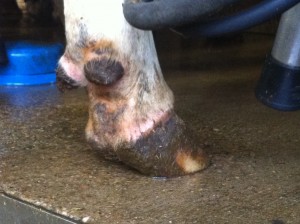Why Fleckvieh Cows Have Longer Production Lives
When studying cattle life cycle, much like a horseman that looks at his horse and says: ”No feet , no horse” , a similar approach should be taken when looking at the life span of dairy cows:
In Veterinary practice and farm visits I have seen many cases of foot diseases that shorten dairy cow lifespan. A lot of problems are management related – for example this means there is poor hoof care or inadequate stalls for cows to lie down without injuring their feet and legs. Some of the problems are not at all management related but relate to the resistance to disease problems in the foot by way of “design”.
Develop Animals With Better Feet and Legs
 The cows suffering from foot problems are suffering pain and discomfort. They lose milk production and are in need of Veterinary care. So not only does the farmer then have production losses, also there is now a need to spend time, money and resources on treatments. In some cases, the problems have advanced so far, that a culling decision is just around the corner. At that point – it is frequently not even possible to ship the animals to slaughter. Why? Because they may have been medicated and there is a withdrawal time for an antibiotic that has to be observed. If the animal gets shipped to slaughter, a long standing condition of pain in the feet and legs will have caused weight loss. In an already compromised state she may end up condemned at slaughter.
The cows suffering from foot problems are suffering pain and discomfort. They lose milk production and are in need of Veterinary care. So not only does the farmer then have production losses, also there is now a need to spend time, money and resources on treatments. In some cases, the problems have advanced so far, that a culling decision is just around the corner. At that point – it is frequently not even possible to ship the animals to slaughter. Why? Because they may have been medicated and there is a withdrawal time for an antibiotic that has to be observed. If the animal gets shipped to slaughter, a long standing condition of pain in the feet and legs will have caused weight loss. In an already compromised state she may end up condemned at slaughter.
So how can a dairy cow have less foot problems? Outside of management, another option is to develop animals with better feet and legs.
Through the use of Fleckvieh genetics, the following benefits can be reaped:
- Inter digital ligament strength. What is this? Each of the claws has the ability to flex or move separately. This makes it possible to navigate rough terrain and also to spread the force over the claws while walking. The two claws are held together by a strong set of ligaments called inter digital ligaments. By design, the claws have to stay closely associated so these ligaments do not get overstressed and stretch or tear. Over time, a foot with weakened ligaments will change to accommodate the pressures of walking. What are these changes? A wider space between the claws, and a change in contact surface that is used for stepping. So the hoof wall which is designed to bear weight now slides away sideways and the hoof horn/center pad is used to bear weight and becomes subject to bruising, foot infections, abscess formation etc. Correction with trimming can only go so far after a while because the foot is still used the wrong way by the cow. In conclusion, a tight inter digital ligament with strong hoof walls make for longer lasting cows.
- Upright position of the pastern area. What is this? Looking at the feet of a mature dairy cow from the side, the goal is to have all the weight spread equally or throughout the whole foot. If however the angles are such that more weight is going to the heel or the back of the foot, more stress is put on the supporting tendons and this causes pain. The animal is going to lose condition and production. Additionally, she may require treatment of infections, sole bruises etc.
Largely – much like in the horse, these things are genetic. A good way to make improvements in production life cycle is to select against these poor foot structures with the mating selection decisions. Fleckvieh animals have very robust feet and can stand up to stresses of modern production longer than many dairy type breeds.